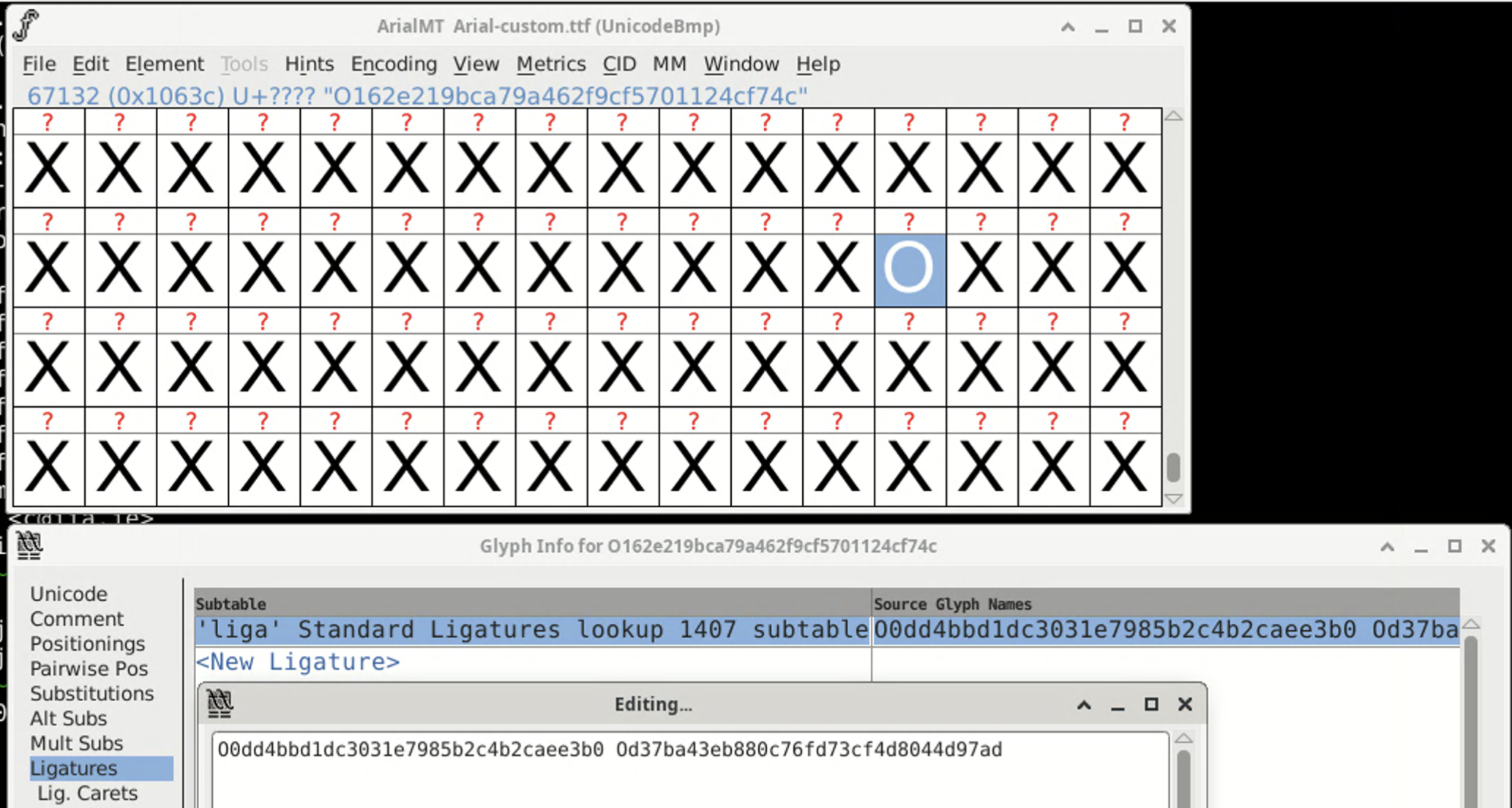FONT LEAGUES
This time, YOU give me the flagIn attachment, a Arial-custom.ttf is found. An html is provided:
<!DOCTYPE html>
<html lang="en">
<head>
<meta charset="UTF-8">
<meta name="viewport" content="width=device-width, initial-scale=1.0">
<title>Enter the flag. You will get an O if it is correct.</title>
<style>
@font-face {
font-family: 'Arial-custom';
src: url('Arial-custom.ttf') format('truetype');
}
textarea {
font-family: 'Arial-custom', sans-serif;
width: 100%;
height: 200px;
font-size: 16px;
}
</style>
</head>
<body>
<h1>Enter the flag. You will get an O if it is correct. Put it in the TFCCTF{...} format before submitting</h1>
<textarea placeholder="Type here..."></textarea>
</body>
</html>It means that if we input the flag, it will be displayed as O. Simple testing reveals that, it replaces two hex characters into one X. It is using the font ligature feature.
Open the font in fontforge, we can find there is an O glyph (named O162e219bca79a462f9cf5701124cf74c) hanging in the middle of many Xs:

And it has ligatures configured: it can be expanded from two another glyphs: O0dd4bbd1dc3031e7985b2c4b2caee3b0 and Od37ba43eb880c76fd73cf4d8044d97ad. We can do this recursively to find the original characters used to generate the glyph sequence.
To find the ligature mappings in Python, we used ttx from fonttools to extract:
pip3 install fonttools
ttx -t GSUB Arial-custom.ttfIn the generated file, the mapping described above is written as:
<Lookup index="1407">
<LookupType value="4"/>
<LookupFlag value="0"/>
<!-- SubTableCount=1 -->
<LigatureSubst index="0">
<LigatureSet glyph="O0dd4bbd1dc3031e7985b2c4b2caee3b0">
<Ligature components="Od37ba43eb880c76fd73cf4d8044d97ad" glyph="O162e219bca79a462f9cf5701124cf74c"/>
</LigatureSet>
</LigatureSubst>
</Lookup>So we need to recursively expand Ligature.glyph into LigatureSet.glyph plus Ligature.components in python:
# pip3 install untangle
import untangle
font = untangle.parse('Arial-custom.ttx')
mapping = dict()
for lig in font.ttFont.GSUB.LookupList.Lookup:
key1 = lig.children[2].children[0]['glyph']
key2 = lig.children[2].children[0].children[0]['components']
val = lig.children[2].children[0].children[0]['glyph']
mapping[val] = (key1, key2)
target = "O162e219bca79a462f9cf5701124cf74c"
numbers = {
"one": 1,
"two": 2,
"three": 3,
"four": 4,
"five": 5,
"six": 6,
"seven": 7,
"eight": 8,
"nine": 9,
"zero": 0,
}
def get(a):
if a in mapping:
key1, key2 = mapping[a]
return get(key1) + get(key2)
else:
if a in numbers:
return str(numbers[a])
else:
return a
print(get(target))Get flag: TFCCTF{1f89a957a0816e3bea3fa026cd9a47cf181fb2c0e0c9e9442a2c783b01c083d2}.
The technique is learned from https://github.com/FFCrewCTF/ctf-writeups/blob/master/2016-11-04-hackthevote/for_250/README.md.